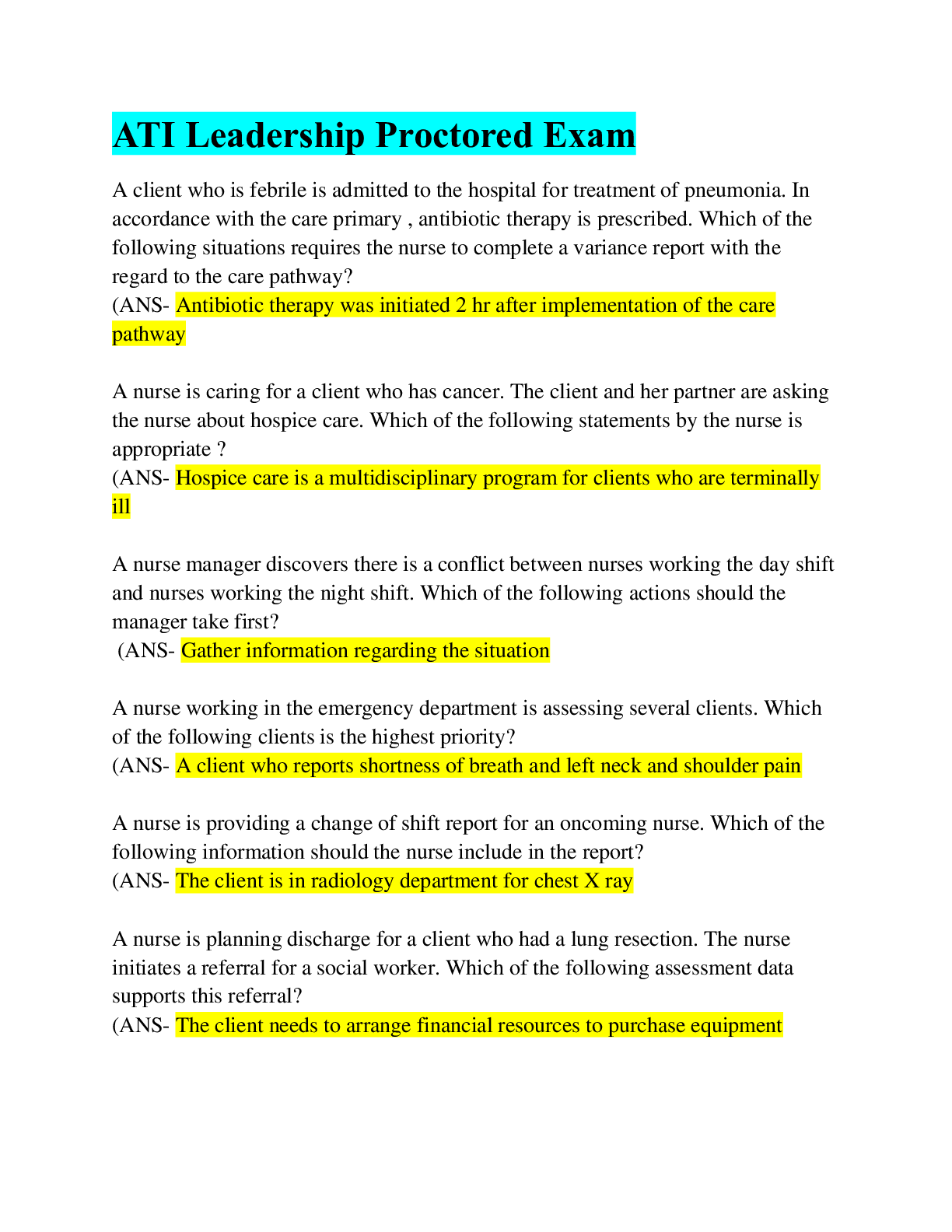Health Care > EXAM > NURS 6560 Midterm Exam (100 Q & A, Year-2020/2021) / NURS 6560N Midterm Exam / NURS6560 Midterm Exam (All)
NURS 6560 Midterm Exam (100 Q & A, Year-2020/2021) / NURS 6560N Midterm Exam / NURS6560 Midterm Exam / NURS-6560N Midterm Exam |Verified Q & A, Includes Latest Exam Set|
Document Content and Description Below
Question 1 S. is a 59-year-old female who has been followed for several years for aortic regurgitation. Serial echocardiography has demonstrated normal ventricular function, but the patient was los... t to follow-up for the last 16 months and now presents complaining of activity intolerance and weight gain. Physical examination reveals a grade IV/VI diastolic aortic murmur and 2+ lower extremity edema to the midcalf. The AGACNP considers which of the following as the most appropriate management strategy? A. Serial echocardiography every 6 months B. Begin a calcium channel antagonist C. Begin an angiotensin converting enzyme (ACE) inhibitor D. Surgical consultation and intervention C. Begin an angiotensin converting enzyme (ACE) inhibitor The patient is having grade 6 diastolic aortic murmur. The murmur is not accompanied by any serious complications because there is a 2+ lower extremity edema to the midcalf. Angiotensin converting enzyme (ACE) inhibitor lowers the blood pressure. High blood pressure often worsens the underlying conditions that cause heart murmurs. Beginning an angiotensin converting enzyme (ACE) inhibitor will help in the management of diastolic aortic murmur by dealing with the conditions that cause heart murmurs. A surgery would be used only when the valves are damaged or leaky Reference https://www.mayoclinic.org/diseases-conditions/heart-murmurs/diagnosis-treatment/drc20373175 Question 2 An ascending thoracic aneurysm of > 5.5 cm is universally considered an indication for surgical repair, given the poor outcomes with sudden rupture. Regardless of the aneurysm’s size, all of the following are additional indications for immediate operation except: A. Comorbid Marfan’s syndrome B. Enlargement of > 1 cm since diagnosis C. Crushing chest pain D. History of giant cell arteritis C. crushing chest pain Prophylactic surgery is recommended when the aorta reaches a diameter of 5.5 cm, when the patient falls under the Marfan syndrome bicuspid aortic valve category, when the enlargement is greater than 0.5 cm, and when the patient has a history of fast-growing cell arteritis. Marfan syndrome is a connective tissue condition that involves the respiratory, skeletal, cardiovascular and ocular systems. It is one of the most serious complication of aortic valve regurgitations and needs an immediate surgery. For this reason, a crushing chest pain is the odd one out Reference https://www.sciencedirect.com/science/article/pii/S235290671500010X Question 3 Jasmine is a 31-year-old female who presents with neck pain. She has a long history of injection drug use and admits to injecting opiates into her neck. Physical examination reveals diffuse tracking and scarring. Today Jasmine has a distinct inability to turn her neck without pain, throat pain, and a temperature of 102.1°F. She appears ill and has foul breath. In order to evaluate for a deep neck space infection, the AGACNP orders: A. Anteroposterior neck radiography B. CT scan of the neck C. White blood cell (WBC) differential D. Aspiration and culture of fluid B. CT Scan of the neck Deep neck space infection may lead to severe and potentially life-threatening complications, such as airway obstruction, mediastinitis, septic embolization, dural sinus thrombosis, and intracranial abscess. In the evaluation of these infections, ultrasonography is the gold standard: 1. to differentiate abscesses from cellulitis 2. for the diagnosis of lymphadenitis However, field-of-view limitation and poor anatomical information confine the use of ultrasonography to the evaluation of superficial lesions and to image-guided aspiration or drainage. Computed tomography (CT) combines fast image acquisition and precise anatomical information without field-of-view limitations. For these reasons, it is the most reliable technique for the evaluation of deep and multi-compartment lesions REFERENCE https://www.ncbi.nlm.nih.gov/pubmed/22964409 Question 4 Mr. Draper is a 39-year-old male recovering from an extended abdominal procedure. As a result of a serious motor vehicle accident, he has had repair of a small bowel perforation, splenectomy, and repair of a hepatic laceration. He will be on total parenteral nutrition postoperatively. The AGACNP recognizes that the most common complications of parenteral nutrition are a consequence of: A. Poorly calculated solution B. Resultant diarrhea and volume contraction C. The central venous line used for infusion D. Bowel disuse and hypomotility C. The central venous line used for infusion Total parenteral nutrition is the administration of nutritional components via the venous system rather than the enteral route/gastrointestinal tract. It can be total or partial where just a selected number of nutrients are given This type of nutrient administration comes with a myriad of challenges as a result of the many complications associated with it. Among the complications the most common is infection which commonly results from the central venous line used. The contamination of the blood stream is with normal skin flora around the cannulation site, commonly staphylococcus organisms The other complications include: 1. Dehydration and electrolyte Imbalances due to inadequate intake 2. Venous thrombosis 3. Hyperglycemia (high blood sugars) 4. Hypoglycemia (low blood sugars) 5. Micro-nutrient deficiencies (vitamin and minerals) Question 5 Mr. Mettenberger is being discharged following his hospitalization for reexpansion of his second spontaneous pneumothorax this year. He has stopped smoking and does not appear to have any overt risk factors. While doing his discharge teaching, the AGACNP advises Mr. Mettenberger that his current risk for another pneumothorax is: A. < 10% B. 25-50% C. 50-75% D. > 90 B. 25-50% Having one pneumothorax increases the chances for a second and third. Mr. Mettenberger has been discharge but no surgical intervention was employed to reduce the odds for a second. He was hospitalized for expansion of his second spontaneous pneumothorax. While he has stopped smoking and does not appear to have any overt risk factors, there is still a 25-50% likelihood of having a third attack because there is no surgical intervention. His current risk for another pneumothorax is 25-50% Reference https://www.ncbi.nlm.nih.gov/pmc/articles/PMC1758641/ https://www.merckmanuals.com/home/lung-and-airway-disorders/pleural-and-mediastinaldisorders/pneumothorax Question 6 One of the earliest findings for a patient in hypovolemic shock is: A. A drop in systolic blood pressure (SBP) < 10 mm Hg for > 1 minute when sitting up B. A change in mental status C. SaO2 of < 88% D. Hemoglobin and hematocrit (H&H) < 9 g/dL and 27% D. Hemoglobin and hematocrit (H & H) <9 g/dL and 27%. Hypovolemic shock occurs due to excessive blood loss, either through hemorrhage or internal bleeding. As blood is lost, hemoglobin is also lost, thus the hemoglobin levels will fall. The normal hemoglobin levels in an adult ranges from 12 - 17.5 g/DL while the normal hematocrit level ranges from 36% - 54%. In hypovolemic shock, the hemoglobin can fall to <9g/dL and the hematocrit can fall to 27%. The blood pressure is likely to fall more than 10mmgHg. The little blood left will be preferably channelled to the brain and the heart thus mental status will not be affected until much later. Question 7 Traumatic diaphragmatic hernias present in both acute and chronic forms. Patients with a more chronic form are most likely to be present with: A. Respiratory insufficiency B. Sepsis C. Bowel obstruction D. Anemia B. Sepsis Patients with more chronic traumatic diaphragmatic hernias are most likely to present with sepsis. Chronic traumatic diaphragmatic hernias can cause bloodstream infections. Additionally, chronic traumatic diaphragmatic can trigger ventilator-associated pneumonia (VAT). Ventilator-Associated pneumonia can trigger the body to release chemicals into the bloodstream to fight the infections. As a consequence, the body's response to the bloodstream infections and ventilator-associated pneumonia can be out of balance. When the body's response to the chemicals is out of balance, the condition that occurs is sepsis References https://www.mayoclinic.org/diseases-conditions/sepsis/symptoms-causes/syc-20351214 https://www.ncbi.nlm.nih.gov/pmc/articles/PMC5359267/ https://www.ncbi.nlm.nih.gov/pmc/articles/PMC3527804/ Question 8 The AGACNP is managing a patient in the ICU who is being treated for a pulmonary embolus. Initially the patient was stable, awake, alert, and oriented, but during the last several hours the patient has become increasingly lethargic. At change of shift, the oncoming staff nurse appreciates a profound change in the patient’s mental status from the day before. Vital signs and hemodynamic parameters are as follows: BP 88/54 mm Hg Pulse 110 bpm Respiratory rate 22 breaths per minute SaO2 93% on a 50% mask Systemic vascular resistance (SVR) 1600 dynes ∙ sec/cm5 Cardiac index 1.3 L/min Pulmonary capillary wedge pressure (PCWP) 8 mm Hg This clinical picture is most consistent with which shock state? A. Hypovolemic B. Cardiogenic C. Distributive D. Obstructive C. Distributive This clinical picture is most consistent with distributive shock state. The vital signs and hemodynamic parameters make distributive shock as the likely shock state. The cardiac features of distributive shock include; a respiratory rate that is greater than 20 breaths per minute, increased pulse pressure, heart rate greater than 90 beats per minute, systolic blood pressure less than 90mmHg , and vascular resistance. The patient has a respiratory rate of 22 breaths per minute, and BP of 88/54mmHg Pulse. For this reason, this clinical picture is consistent with distributive shock state References https://emedicine.medscape.com/article/168689-clinical#b3 https://www.medscape.com/answers/168402-27289/what-are-the-causes-and-signs-ofdistributive-shock Question 9 When counseling patients to prevent postoperative pulmonary complications, the AGACNP knows that with respect to smoking cessation, the American College of Surgeons and National Surgical Quality Improvement Program guidelines are clear that patients who stop smoking _____ weeks before surgery have no increased risk of smoking related pulmonary complications. A. 2 B. 4 C. 6 D. 8 Question 10 Mitch C. is a 39-year-old male who is brought to [Show More]
Last updated: 1 year ago
Preview 1 out of 63 pages

Reviews( 0 )
Document information
Connected school, study & course
About the document
Uploaded On
Jul 20, 2022
Number of pages
63
Written in
Additional information
This document has been written for:
Uploaded
Jul 20, 2022
Downloads
0
Views
26


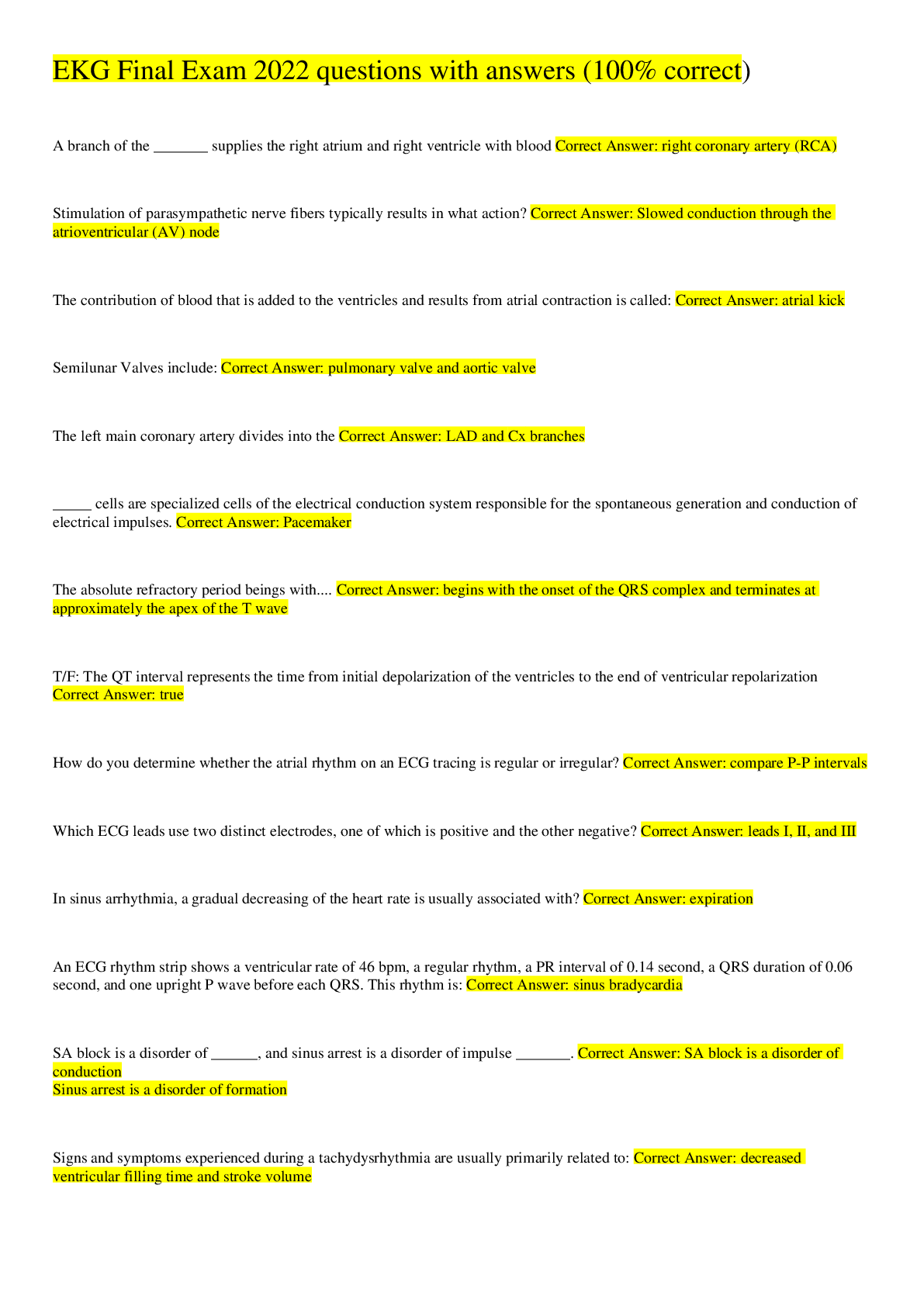
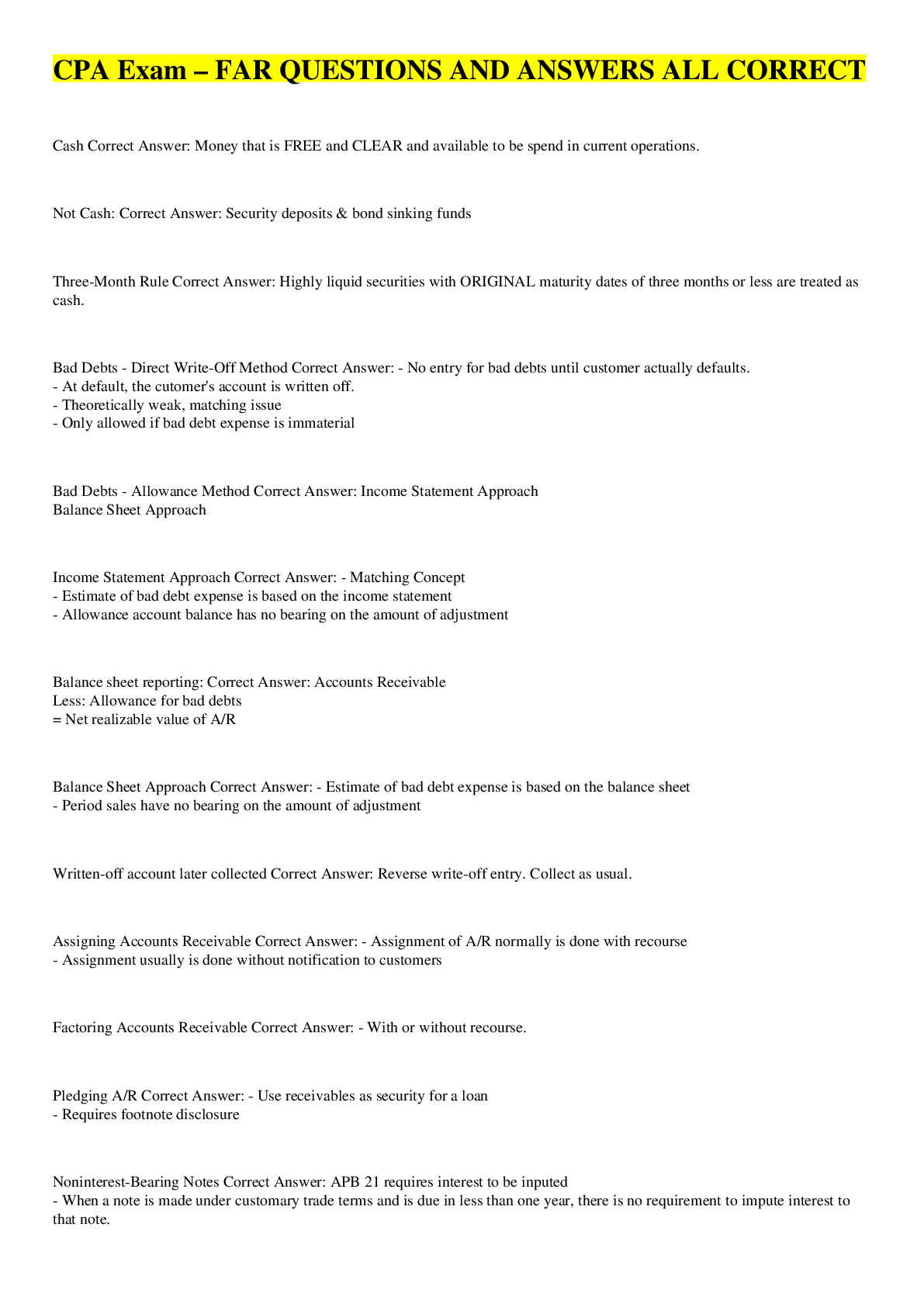
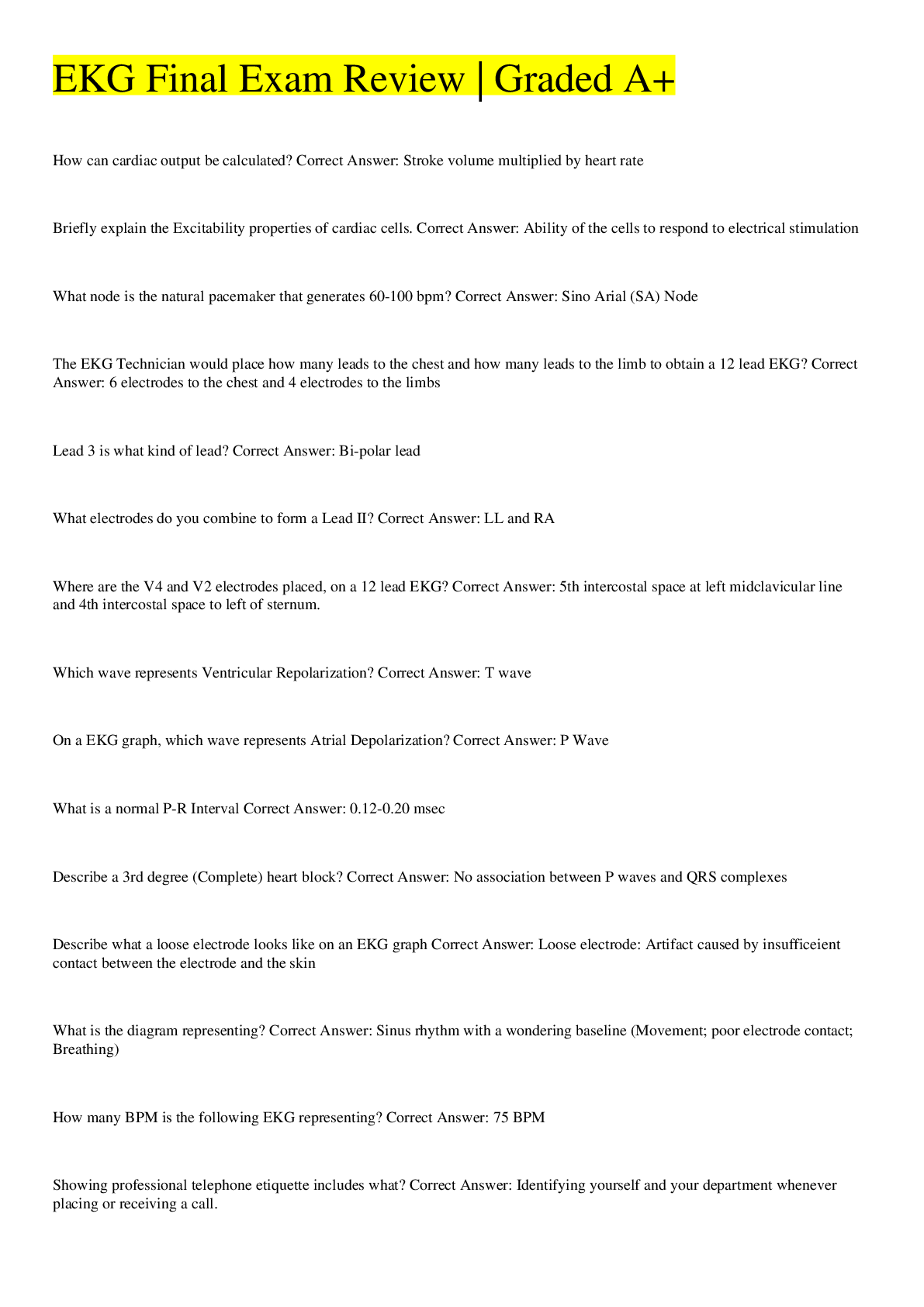
.png)




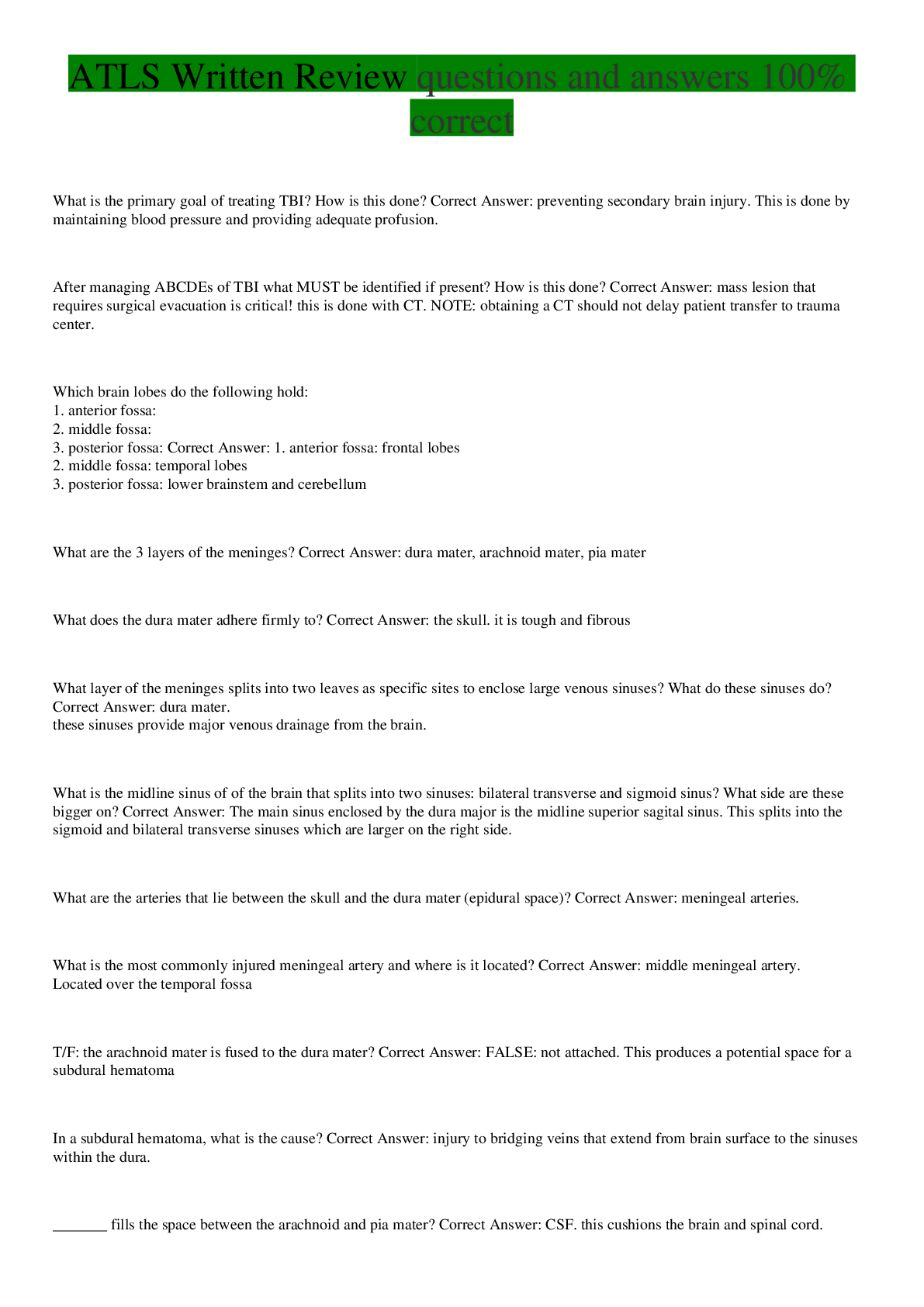
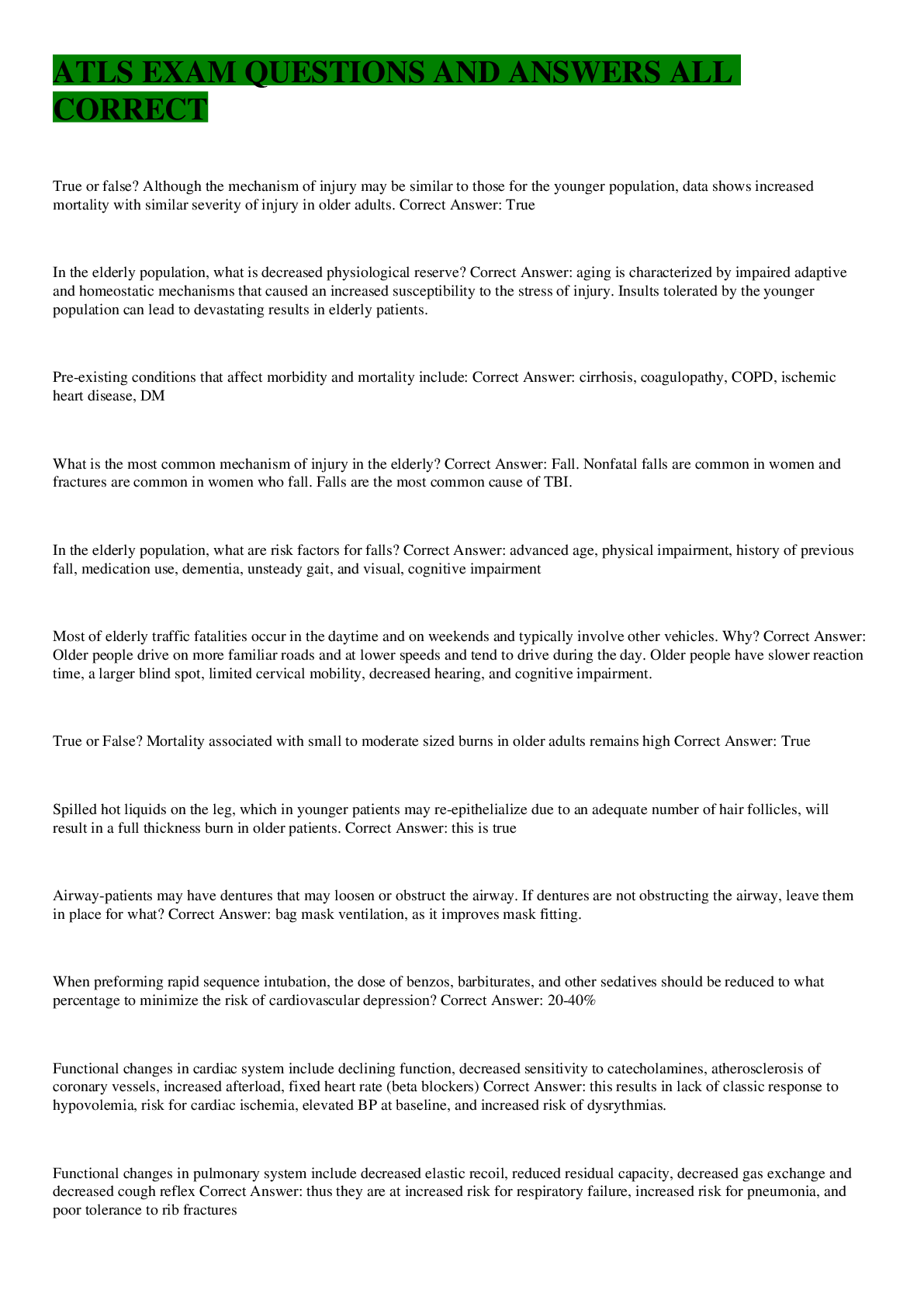


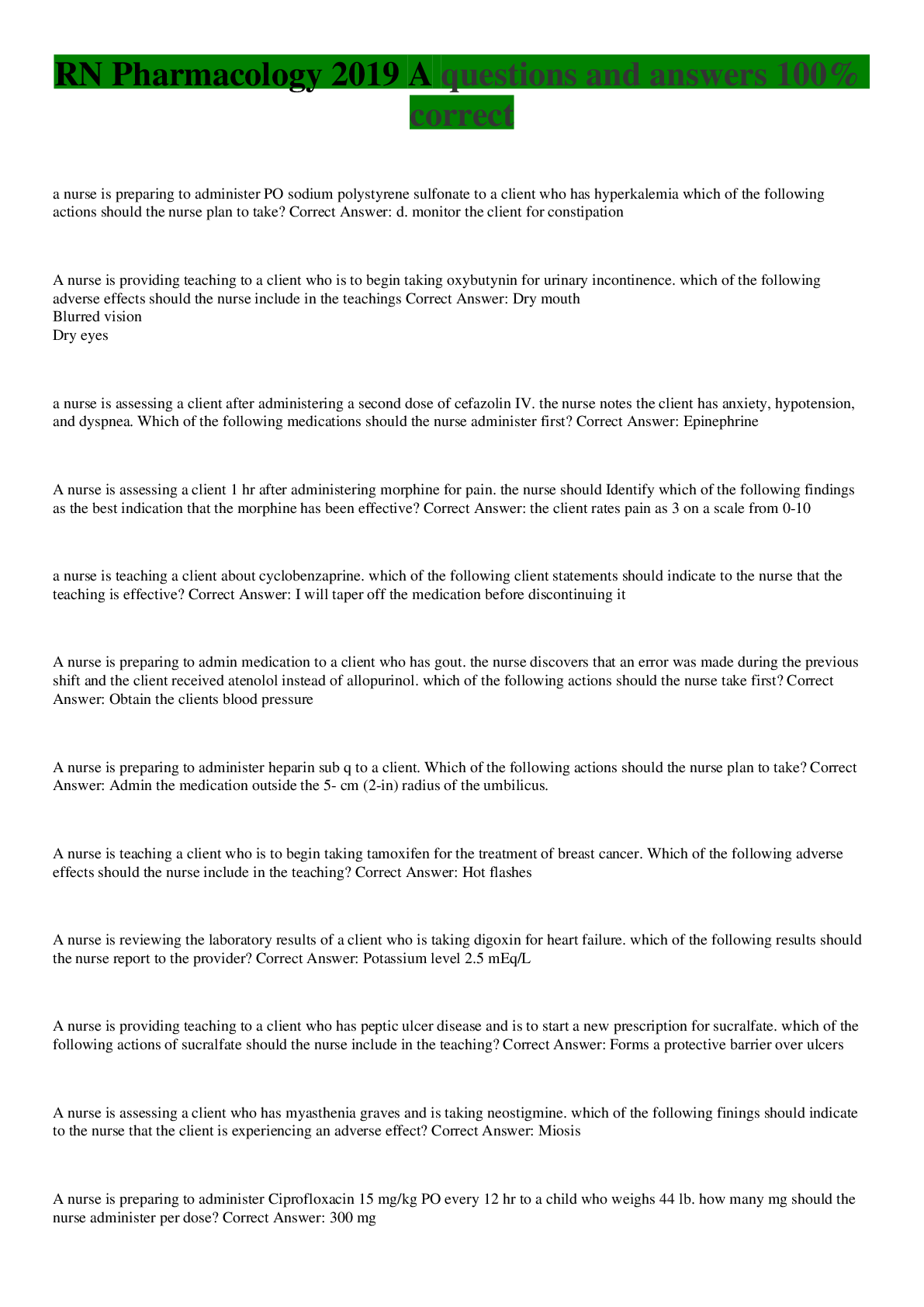




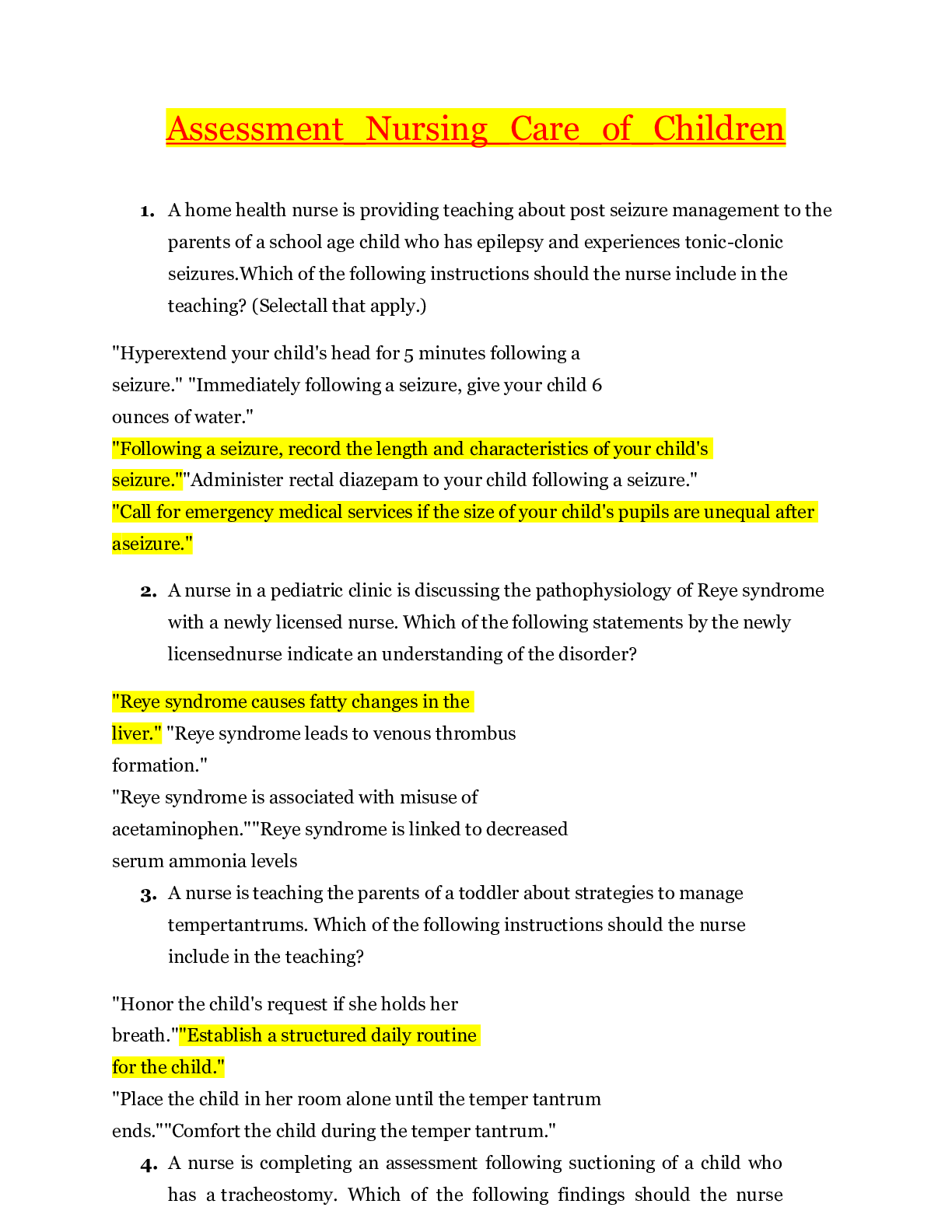


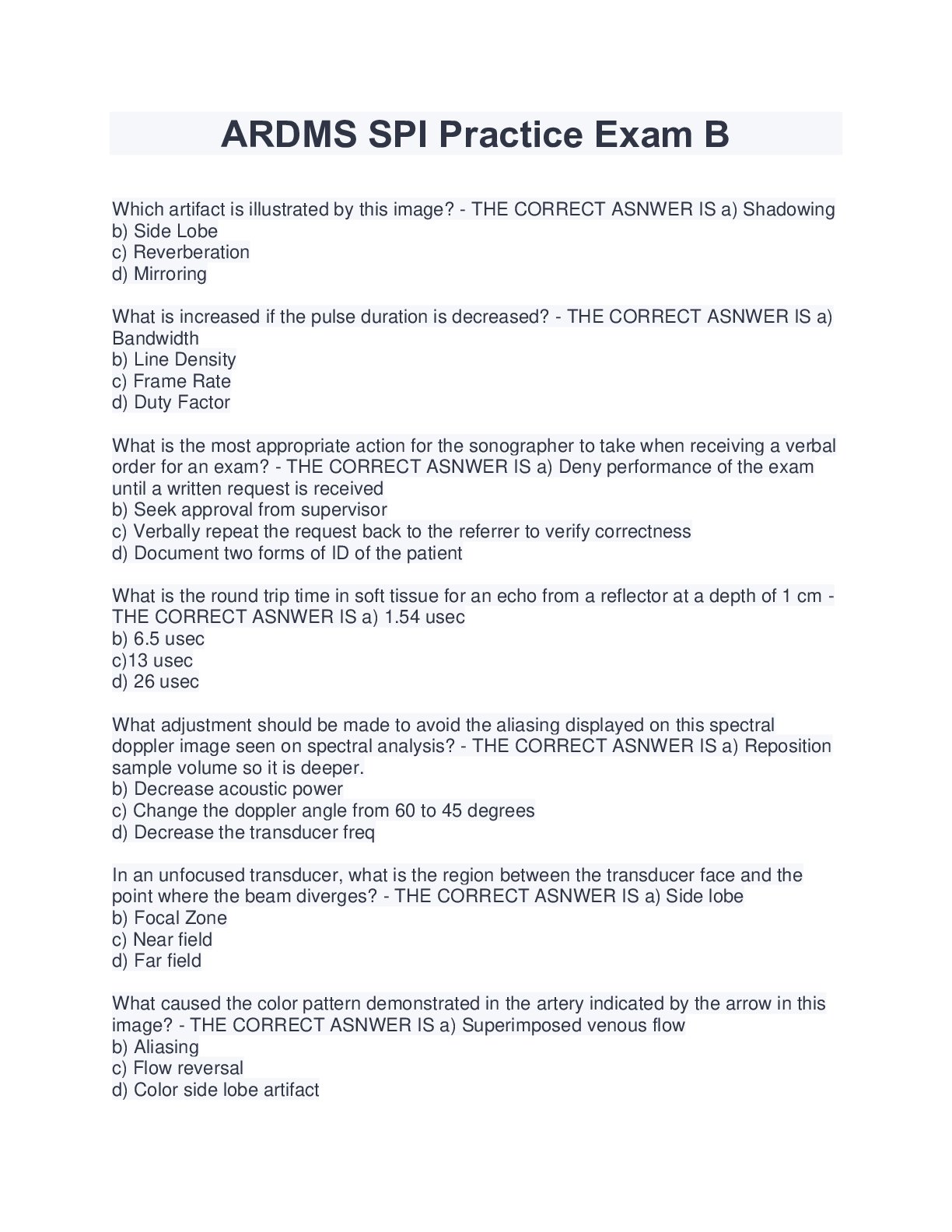
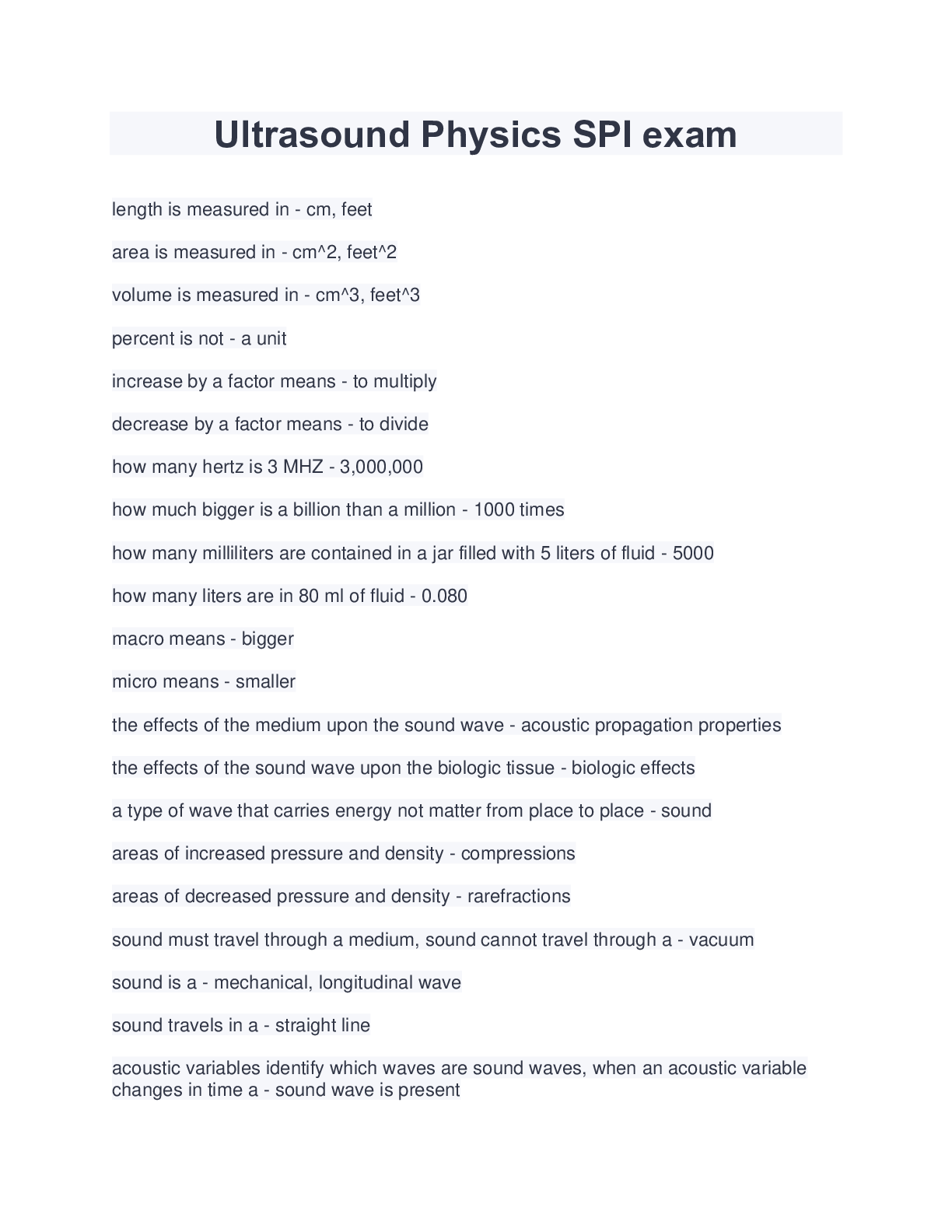
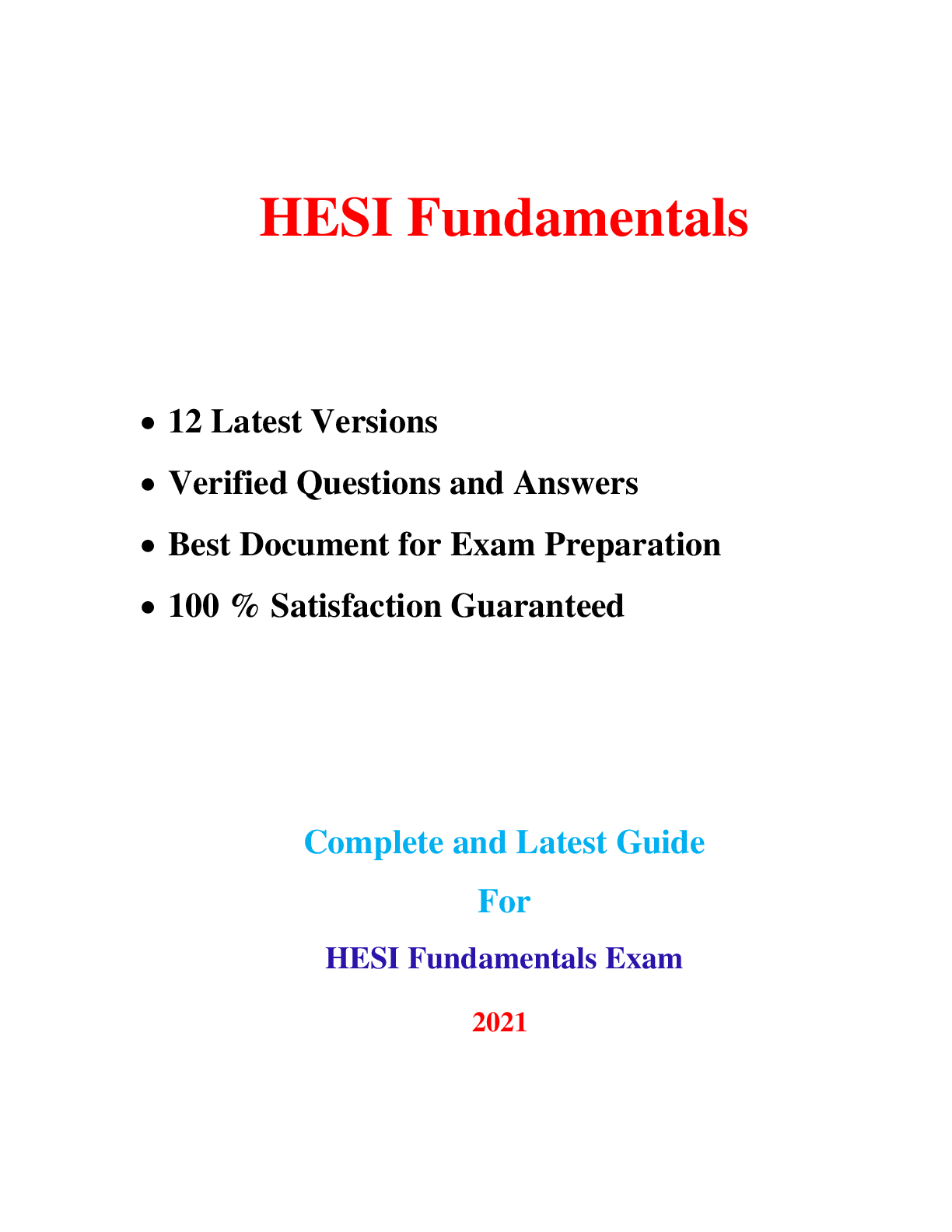

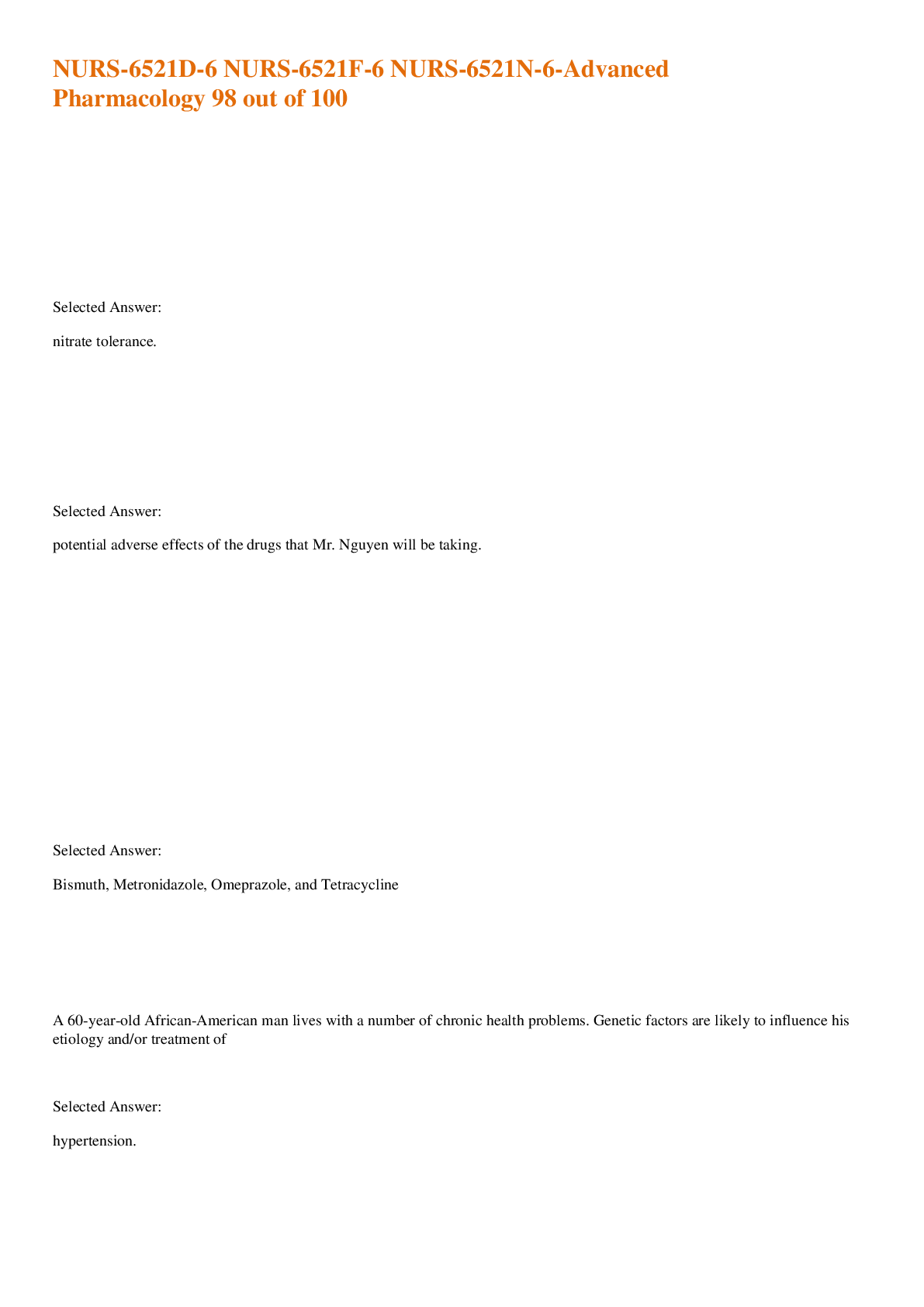
.png)

.png)
